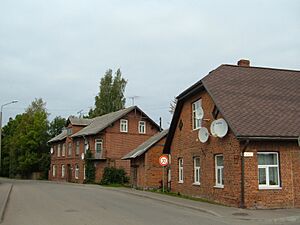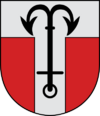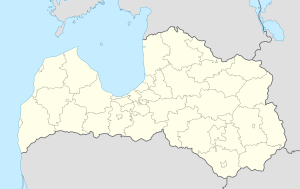Salacgrīva facts for kids
Quick facts for kids
Salacgrīva
|
|||
|---|---|---|---|
|
Town
|
|||

Street in Salacgrīva
|
|||
|
|||
| Country | |||
| Municipality | Limbaži Municipality | ||
| Town rights | 1928 | ||
| Area | |||
| • Total | Lua error in Module:Wd at line 1,575: attempt to index field 'wikibase' (a nil value). km2 (Formatting error: invalid input when rounding sq mi) | ||
| • Land | Lua error in Module:Wd at line 1,575: attempt to index field 'wikibase' (a nil value). km2 (Formatting error: invalid input when rounding sq mi) | ||
| • Water | Expression error: Unexpected < operator. km2 (Formatting error: invalid input when rounding sq mi) | ||
| • Rural territory | 312.83 km2 (120.78 sq mi) | ||
| Population
(2024)
|
|||
| • Total | 2,480 | ||
| Time zone | UTC+2 (EET) | ||
| • Summer (DST) | UTC+3 (EEST) | ||
| Postal code |
LV-403(2-4)
|
||
| Calling code | +371 640 | ||
| Number of city council members | 15 | ||
Salacgrīva is a town in the Limbaži Municipality in the Vidzeme region of Latvia. Its name means "Mouth of Salaca" because it's located where the Salaca River meets the sea. Since 2007, Salacgrīva has been famous for hosting the Positivus Festival, a big music event that brings in many visitors every July.
Salacgrīva is about 103 kilometers (64 miles) from Riga, the capital of Latvia. It's also 50 kilometers (31 miles) from Limbaži and 95 kilometers (59 miles) from Valmiera. The town's economy mainly relies on exporting timber, making wood products, food production, and trade.
Contents
History of Salacgrīva
Early Beginnings and a Knight's Castle
Salacgrīva was first known as a settlement around the early 5th century. At that time, the Livonians had a village called Saletsa near the mouth of the Salaca River. Many centuries later, a knight's castle was built there. It was named after Bishop Albert of Riga.
This castle was attacked several times during the Livonian war. By the late 17th century, it was badly damaged and eventually fell apart. You can still see the old canal where boats used to sail around the castle mound in Salacgrīva. The Livonians lived in this area until the mid-19th century, when their local language, the Salaca Livonian dialect, disappeared.
Growth as a Port Town
Salacgrīva grew as shipping along the coast of the Gulf of Riga became more important. To help bigger ships, the Salaca River was made deeper. A pier made of large stones was also built at the river's mouth.
Salacgrīva became a key place for sending goods from Northern Vidzeme, like timber, linen, and crops. These goods were shipped to Pärnu and Riga. Around this time, about 200 ships came into the port each year. This helped the town grow, and more people moved there. By the end of the 19th century, Salacgrīva had over 70 homes and 40 warehouses.
However, in the early 20th century, fewer goods came through Salacgrīva. This was because new railways were built in Vidzeme. Most products then went through the new port in Ainaži, which had a direct train connection.
Modern Times and New Industries
After Latvia became independent in the early 20th century, Salacgrīva's community life became very active. The first secondary school was opened in 1921. On February 7, 1928, Salacgrīva officially became a town.
During the Soviet era, the town's economy changed. A fish processing plant was built there, and a fishing group called "Brīvais vilnis" was started. Because of the growing fishing industry, the port was updated. An outdoor stage was also built for the popular Fisherman's Day festival, which is now called the Sea Festival.
Today, Salacgrīva is a growing town in Latvia. Timber export, wood processing, food production, and trade are still very important for its economy.
Transportation
Salacgrīva is located on the A1 road (Latvia). This road is part of the Via Baltica international highway. This location is great for transit and transport businesses.
Tourism in Salacgrīva
After Latvia regained its independence, Salacgrīva was home to the first tourism information center in the country. It started helping travelers in 1993. The center still gives useful tips to visitors, encouraging them to come back.
Most foreign tourists who visit Salacgrīva come from Estonia, Germany, Finland, Lithuania, and Russia.
Popular Tourist Spots
Here are some of the most popular places to visit:
- Positivus Festival - This is a huge three-day summer music and culture festival. It features many types of music, like indie, pop, and electronic. Positivus Festival has won awards and is known as one of Europe's top music festivals. Since 2022, it has moved to Riga.
- Lamprey Weirs - This is a special and old way of fishing for lamprey. It's only used in Salacgrīva today. A lamprey weir is a unique wooden walkway built over the river. Every year, before the fishing season, these weirs are built from fresh spruce timber. Fishermen use special ties instead of nails or screws to hold them together.
- The Treasury - Here, you can see many old items from the Soviet period. This includes magazines, books, toys, dishes, and even old audio, video, and camera equipment.
- The Museum of Salacgrīva - This museum has a permanent exhibit called "Zutiņš murdā" (Lamprey in the fish pot). It shows the history of fishing and traditions along the Vidzeme seaside, including the ancient lamprey fishing method.
- Salaca Promenade and the Lighthouse - The lighthouse was built in 1925. It's a white rectangular tower with a red light. It no longer works but used to guide fishermen home. It was built because of many sandbanks near the coast, which made the Gulf of Riga dangerous for ships. To protect the Salaca shores from erosion, locals built a promenade. It was made by bringing in stones from the area and opened in May 2014.
- The Naborigama Ceramics Stove - This special cocklestove, or naborigama, was built in 2007. It can reach very high temperatures, over 1300 degrees Celsius, for baking china. Every July, the stove is heated for a week to reach this heat. After it cools, artists gather to see their finished pottery.
Culture
Library
A group called the Social Association of Salacgrīva started a library in 1902. It was first located in their association building, built in 1912. The library started with 300 books and later grew to 700. In 1957, the library split into two: the Salacgrīva town library and a separate children's library.
Museum
The Museum of Salacgrīva opened in 1998. It's a center for learning about the region's history. The museum has information about fishing in the Salaca River area and along the Northern Vidzeme coast. You can learn about old lamprey fishing methods, the history of Salaca and Svētciems manor houses, and the town's economic and political life. It also has details about schools, churches, and famous local people who have done great things in teaching, science, culture, arts, business, and politics.
Local Events
Salacgrīva hosts many fun events throughout the year:
- The Mask Festival happens in February. You can join workshops to make your own mask and enjoy traditional music.
- In May, there are two events: The Museum Night and Raftsmen Festival. At the Raftsmen Festival, you can learn how to tie rafts using old tools.
- June is for the Acoustic Music Festival. This festival promotes acoustic music. You can also join workshops and seminars about old musical instruments.
- On the second Saturday of July, people celebrate the Sea Festival. There's a fish market, concerts, dances, and boat rides.
- A week later, Positivus takes place. It's the biggest music and art festival in the Baltic countries.
- The Classical Music Festival is at the end of July, featuring many high-quality classical music concerts.
- August brings the Salacgrīva Town Festival. It starts on Friday night with historical films. Saturday morning has a big local market, creative workshops, activities, and concerts.
- To encourage a healthy lifestyle, the Marathon of Three Bridges is held every September. It's a 6.5-kilometer (4-mile) race that has been run for over thirty years.
- The Day of Lamprey is celebrated on the second Saturday of October. On this day, you can see the lamprey weirs on the Salaca River and Svētupe. You can also taste lamprey soup and hot fried lamprey. People can watch how lamprey are caught and enjoy songs and dances about the sea and fishermen.
Sport
The municipalities of Salacgrīva and Limbaži work together to run the Limbaži and Salacgrīva Municipality Sports School.
Basketball is the most popular sport in Salacgrīva. The Salacgrīva Basketball Club is the main group that supports basketball. Their senior team, BK Salacgrīva, plays in the 3rd division of the Latvian Basketball League. The club has four teams in total.
The first team to play for Salacgrīva in the Limbažu regional basketball championship was A/S Brīvais Vilnis in 1994. The most successful team has been Zvejnieku parks, with 5 championship titles. BK Salacgrīva also has 5 championship titles. In 2011, all basketball teams in Salacgrīva joined together to form the Basketball Club Salacgrīva.
Popular sports events include "Beach streetball" on the Salacgrīva seashore. There's also the "Salacgrīvas Krastu mačs" (Salacgrīva Bank Match). In this event, the Salaca River divides the teams: one team represents the left side of the municipality, and the other represents the right side.
Basketball Club Salacgrīva
| BK Salacgrīva | |||||
|---|---|---|---|---|---|
| Leagues | RBL | ||||
| Founded | 2009 (1994) | ||||
| History | Zvejnieku parks (1999–2011) (2009–present) |
||||
| Arena | Salacgrīva Secondary School | ||||
| Capacity | 300 | ||||
| Location | Salacgrīva, Latvia | ||||
| Team colors | Blue and White |
||||
| Main sponsor | Council of Salacgrīva Municipality | ||||
| President | Jevgenijs Mihailovskis | ||||
| Team manager | Jevgēnijs Mihailovksis | ||||
| Head coach | Kaspars Neimanis | ||||
| Championships | 1 3.division 10 OC Limbaži |
||||
|
|||||
BK Salacgrīva is a Latvian amateur basketball team based in Salacgrīva. They won the Latvian Basketball League 3rd division championship in 2014. The team first started playing in LBL-3 in 2009.
Religion
Churches in Salacgrīva
- St. Mary's Goreti Church (Catholic church) – This "new" Catholic church was blessed by Jānis Pujats on July 27, 1997. The architect who designed it was Dagnis Straubergs, who was also the Chairman of Salacgrīva Municipality. The beautiful mosaic inside the church was created by Mārīte Folkmane. The large altar cross and a copy of Christ were made by artist Pēteris Bārda.
- Lielsalaca Evangelical Lutheran Church – This church was first built from wood in 1777. It was rebuilt with stone between 1853 and 1857. The church was made bigger in 1892, adding an altar room with 500 seats. More renovations happened in 1927. The church celebrated its 200th anniversary on July 10, 1997.
- Salacgrīva St. Virgin Shelter Orthodox Church – This Orthodox church was built in 1873. Its architect, R. Pflug, also designed the famous Nativity of Christ or Orthodox Cathedral in Riga.
Images for kids
See also
 In Spanish: Salacgrīva para niños
In Spanish: Salacgrīva para niños








